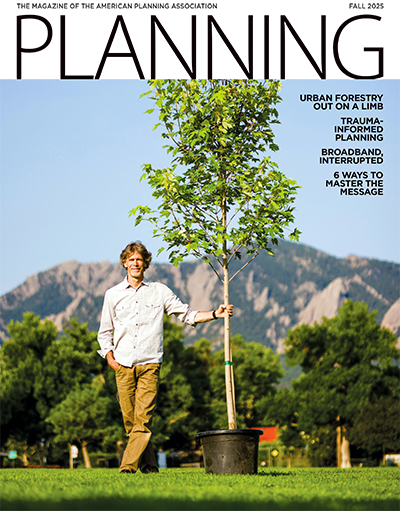Aug. 22, 2024
"How well do you really know your own processes?" asks Rebecca Everette, AICP, community development director for Larimer County, Colorado. In a conversation with Sophia Burns, content associate at the American Planning Association (APA), Everette shares the unusual way that she learned what the resident's side of her city's permitting process was like — and how that experience taught her the importance of empathy as a planner. This conversation is part of Short Takes, a miniseries of the APA Podcast recorded onsite during the APA 2024 National Planning Conference in Minneapolis.
This interview has been edited for length and clarity, but you can listen to the complete conversation at planning.org/podcast or wherever you get your podcasts.
BURNS: You're a planner. How did you end up on the other side of your city's permitting process?
EVERETTE: In 2018, I was the development review manager for the City of Fort Collins, Colorado. I managed planners, development review coordinators, zoning inspectors, and building permit technicians. I was, by all accounts, an expert in my city's processes for development, review, and planning. I was also about to embark on a major addition to my 1910 Sears, Roebuck catalog home. Of course, that wasn't as simple as hiring a contractor and pulling a permit.
The process involved historic review, setback variances that required public hearings, and an after-the-fact permit for a past illegal addition — all before we even got to the standard building permit and inspection process. I was so confident going in. I was sure I knew how everything worked in my department.
But being a planner and a process nerd, I treated it like I was a secret shopper and documented everything along the way, noting which steps were frictionless and easy and which were confounding and frustrating.
BURNS: So, you got the full resident experience of your city's planning department.
EVERETTE: Yes! I experienced variance hearings, failed inspections, unexpected process delays, miscommunications, and cost escalations. And it was surprisingly difficult. After I got my certificate of occupancy, I took my notes to our community development director to help us identify some opportunities for improvement within our department.
BURNS: What were your main takeaways?
EVERETTE: First, everyone hates bureaucracy, including those on the inside. And, we often rely on customer service to compensate for our cumbersome processes. Sometimes, that masks what's actually wrong with the process itself.
Second, there are humans on both sides, and empathy and a commitment to making each other's lives easier can go both ways.
"Everyone hates bureaucracy, including those on the inside. And, we often rely on customer service to compensate for our cumbersome processes. Sometimes, that masks what's actually wrong with the process itself."
Third, seemingly minor decisions on the government side can cause pretty major delays and financial impacts to the customer.And, finally, if you haven't been in the customer's shoes yourself, you probably don't have a complete understanding of how your process works in detail.
BURNS: How do you think planners should go about identifying issues in their processes?
EVERETTE: I don't necessarily suggest going about it the way I did, but there are ways you can approximate the customer experience without actually being the customer yourself. One tool I suggest is customer experience mapping. Experience mapping is a way of understanding and bringing visibility to the detailed steps of your process through somebody else's eyes. You conduct post-process interviews with applicants, particularly inexperienced customers, and ask them to explain their experience at each step of the process to identify pain points you probably don't see on the other side.
BURNS: What other tools would you recommend to planners looking to improve their processes?
EVERETTE: Job shadowing is another great one to use with other members of your team or between teams to understand how everyone's portion of the process works and to gain a broader view of the overall system.
I've also used something that I like to call an empathy panel, which is asking customers to come into the office and share their stories directly with the staff who work on these tasks day-to-day. That helps to put a human face to the work that we do.
But, if you're really brave, you can do it yourself! Get yourself a home equity loan and become a secret shopper. I guarantee you'll learn far more than you expected.
BURNS: You've mentioned empathy a few times. We've been focusing on empathy in our Upskilling Initiative at APA. How can planners train that empathy muscle?
EVERETTE: Empathy really is an undervalued skill in our whole society right now. Planners strengthen that muscle by really focusing on asking questions of the people across the table.
When you have an instinct to answer or to provide information, asking a question instead can be really powerful. Maybe instead of talking about regulations, ask, "What is it that you need to be successful?" This can open a whole different conversation with the customer that can build a deeper understanding, so you can see the why behind someone else's actions or choices.




